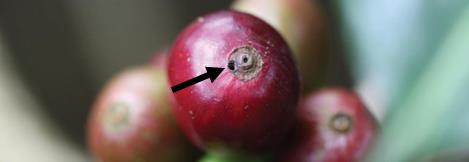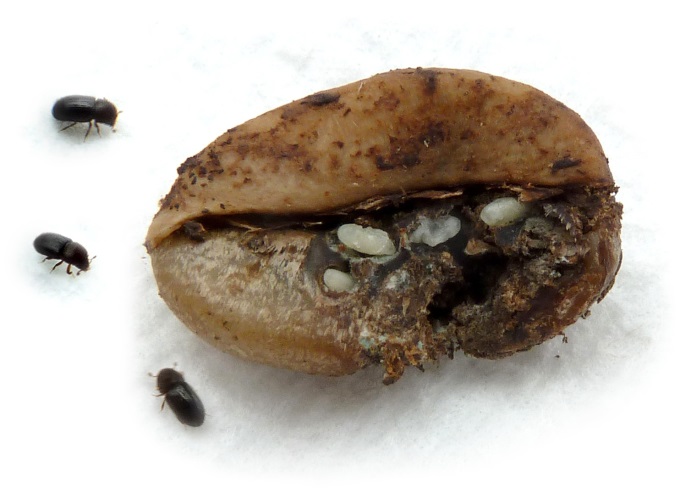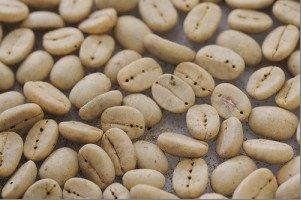
Coffee berry borer
| Primefact number | Edition | Published | Author |
|---|---|---|---|
| 1619 | First | Dec 2017 | Plant Biosecurity and Product Integrity |
![Figure 1. Adult female coffee berry borer on a green coffee bean [approx. 1.5 mm] (Image: Peggy Greb, USDA Agricultural Research Service, Bugwood.org) A coffee bean with a small black beetle on the surface](https://www.dpi.nsw.gov.au/__data/assets/image/0020/802910/CoffeeBerryBorer1.jpg)



Coffee berry borer (Hypothenemus hampei) is not present in Australia. This pest is a serious threat to Australia’s coffee industry.
Coffee berry borers are a small species of beetle that live, feed and breed inside coffee berries. The damage to the berry severely impacts the quality of coffee beans produced.
Notifiable status
Coffee berry borer (Hypothenemus hampei) is not a notifiable plant pest in NSW.
However, if you suspect coffee berry borer:
- Call the Exotic Plant Pest Hotline 1800 084 881
- Email biosecurity@dpi.nsw.gov.au with a clear photo and your contact details
A full list of notifiable plant pests and diseases can be found in Schedule 2 of the NSW Biosecurity Act 2015.
Description
Adults
Adult coffee berry borer beetles are black and about 1.5 mm long (Figure 1). Although it is difficult to see distinctive characteristics with the naked eye, short club shaped antenna and short stiff hairs covering the body can be seen under magnification.
Many beetles can often be found in a single coffee berry. Records have up to as many as 100 beetles within the one berry.
Immature stages
Larvae and eggs of coffee berry borer occur within the infested berries and remain within until adults.
Damage
The first sign of coffee berry borer attack can be seen at the tip of the berry, around 8 weeks after flowering. A small hole about 1 mm big is often clearly visible (Figure 2). As the adult bores into the berry, sawdust-like material may be pushed out of this hole.
If the berry begins to rot, the borers may abandon their berry to find a new one. If the adult remains to lay eggs, the following larval feeding, pupation and boring by adults causes extensive damage within the berry (Figure 3). The damage done can cause the berries to fall prematurely.
Overall damage to a crop can vary, but berries can be completely consumed by adults and larvae so that all that remains is waste. It is not uncommon for 100% of berries to be attacked. Berries that remain intact until harvest often have visible holes, reducing value (Figure 4).
Lifecycle
Adult coffee berry borers feed and breed inside the berries. Males have short wings and do not fly; they remain in the berries for their 3 month life span. Females are fertilised a few days before they leave the berries to find other berries in which to lay their eggs.
Each female can produce 30–50 eggs in 2–7 weeks. The eggs generally hatch within a week and larvae start to feed on the bean. After about 2 weeks, the larvae pupate and emerge as adults 4–9 days later. The full life cycle takes 4 weeks.
The borers overwinter by remaining inactive in dry berries on the plant or ground.
Hosts
Hosts of coffee berry borer include brazil nut and Coffea species including Coffea arabica (arabica) and Coffea canephora (robusta).
Spread
Female coffee berry borers can fly for about 30 minutes to spread locally. They can also swarm, potentially using updrafts of air to achieve long distance travel.
The introduction of coffee berry borer to Australia is most likely to occur with imported coffee plant material or green beans infested with borers.
Distribution
Coffee berry borer is known to occur in Asia, Africa, South and Central America, the Caribbean and Oceania. In Oceania it is recorded in Micronesia, Fiji, French Polynesia, New Caledonia, Northern Mariana Islands, Papua New Guinea, and Hawaii.
Actions to minimise risks
Put in place biosecurity best practice actions to prevent entry, establishment and spread of pests and diseases:
- practice “Come clean, Go clean”
- ensure all staff and visitors are instructed in and adhere to your business management hygiene requirements
- source propagation material of a known high health status from reputable suppliers
- inspect imported green bean for signs of infestation
- monitor your coffee plants and fruit regularly
- keep records

